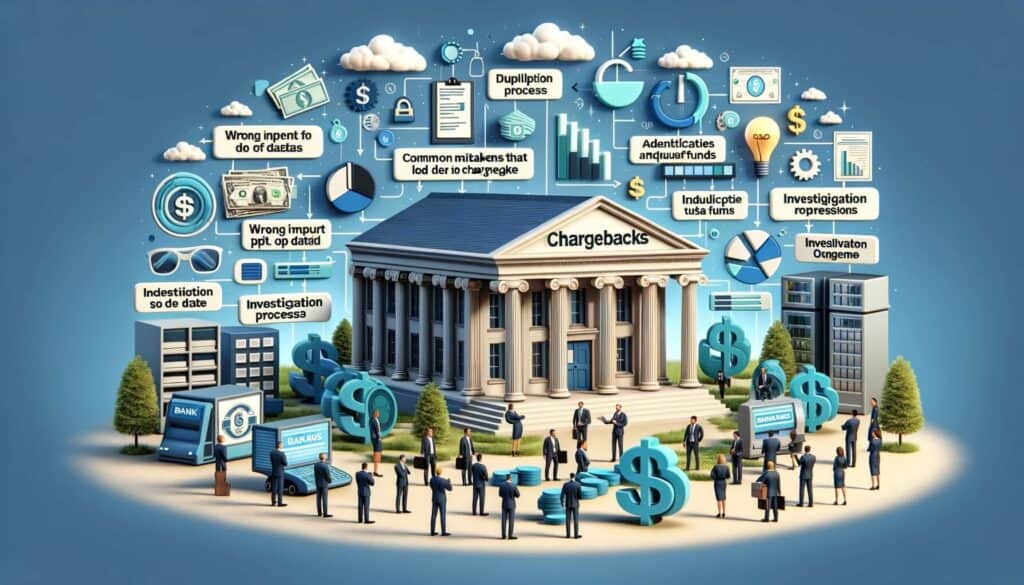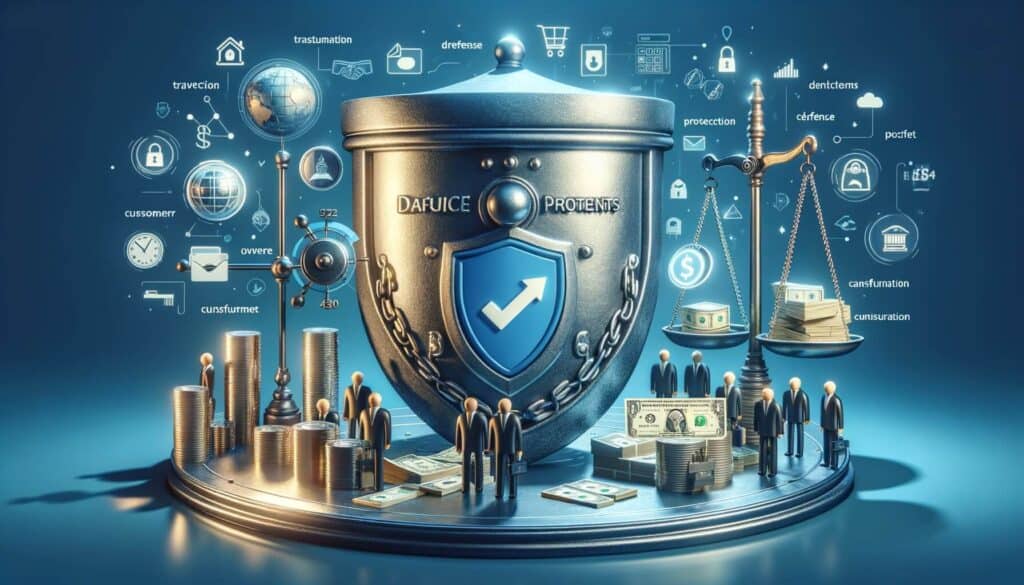
By Harriet Forster January 15, 2025
In today’s digital age, where online transactions have become the norm, the concept of bank chargebacks has gained significant importance. A bank chargeback refers to the process of reversing a transaction and returning funds to a customer’s account. It is a mechanism designed to protect consumers from fraudulent or unauthorized transactions, as well as to resolve disputes between customers and merchants.
In this comprehensive guide, we will delve into the intricacies of bank chargebacks, exploring their basics, the process of initiating them, common reasons for their occurrence, and how to prevent them. We will also examine the role of banks in resolving chargebacks, the impact they have on merchants, and the consumer protection aspect associated with them.
Understanding the Basics of Bank Chargebacks
To comprehend the concept of bank chargebacks, it is essential to understand the parties involved in a transaction. When a customer makes a purchase, the funds are transferred from their bank account to the merchant’s account. However, if the customer is dissatisfied with the product or service received, or if they suspect fraudulent activity, they can request a chargeback. This prompts the bank to reverse the transaction and return the funds to the customer.
Chargebacks are governed by various regulations and guidelines, such as those set by card networks like Visa and Mastercard. These guidelines outline the circumstances under which a chargeback can be initiated, the time limits for filing a chargeback, and the evidence required to support the claim. It is crucial for both customers and merchants to familiarize themselves with these guidelines to ensure a smooth chargeback process.
The Process of Initiating a Bank Chargeback

Initiating a bank chargeback involves a series of steps that must be followed by the customer. The first step is to contact the bank and inform them of the disputed transaction. The bank will then guide the customer through the chargeback process, which typically involves filling out a chargeback request form and providing supporting documentation. This documentation may include evidence of communication with the merchant, proof of return of goods, or any other relevant information that strengthens the customer’s case.
Once the chargeback request is submitted, the bank will review the claim and assess its validity. If the claim is deemed legitimate, the bank will initiate the chargeback process, reversing the transaction and returning the funds to the customer’s account. However, if the claim is found to be invalid or insufficient, the bank may reject the chargeback request, leaving the customer responsible for the disputed transaction.
Common Reasons for Bank Chargebacks

Bank chargebacks can occur for a variety of reasons, ranging from fraudulent activity to customer dissatisfaction. Some of the most common reasons for chargebacks include:
1. Fraudulent Transactions: Chargebacks are often initiated when a customer’s card information is stolen or used without their authorization. In such cases, the customer can dispute the transaction and request a chargeback to recover their funds.
2. Non-Delivery of Goods or Services: If a customer pays for a product or service but does not receive it within the specified timeframe, they can initiate a chargeback. This is particularly common in online transactions, where customers may fall victim to scams or unreliable merchants.
3. Defective or Substandard Products: Customers have the right to receive products that meet their expectations in terms of quality and functionality. If a customer receives a defective or substandard product, they can request a chargeback to recover their funds.
4. Unauthorized Transactions: If a customer notices unauthorized transactions on their bank statement, they can immediately contact their bank and request a chargeback. This is crucial in cases of identity theft or card skimming.
5. Billing Errors: Sometimes, merchants may make errors in billing, resulting in incorrect charges on a customer’s account. In such cases, the customer can request a chargeback to rectify the error and recover their funds.
How to Prevent Bank Chargebacks

While chargebacks are a necessary mechanism to protect consumers, they can have a significant impact on merchants. Chargebacks can result in financial losses, damage to reputation, and increased operational costs. Therefore, it is crucial for merchants to take proactive measures to prevent chargebacks. Here are some effective strategies to minimize the occurrence of chargebacks:
1. Clear and Transparent Communication: Merchants should ensure that all product or service information, including pricing, terms, and conditions, is clearly communicated to customers. This helps manage customer expectations and reduces the likelihood of disputes.
2. Prompt Customer Support: Providing prompt and efficient customer support is essential in resolving customer issues and preventing chargebacks. Merchants should have a dedicated support team that can address customer concerns and provide timely assistance.
3. Secure Payment Processing: Implementing robust security measures for payment processing is crucial in preventing fraudulent transactions. Merchants should use secure payment gateways and comply with industry standards for data protection.
4. Accurate Product Descriptions: Merchants should provide accurate and detailed product descriptions, including images and specifications. This helps customers make informed purchasing decisions and reduces the likelihood of dissatisfaction.
5. Easy Return and Refund Policies: Having clear and customer-friendly return and refund policies can significantly reduce the occurrence of chargebacks. Merchants should make it easy for customers to return products and receive refunds when necessary.
The Role of Banks in Resolving Chargebacks
Banks play a crucial role in the chargeback process, acting as intermediaries between customers and merchants. When a customer initiates a chargeback, the bank is responsible for reviewing the claim, assessing its validity, and facilitating the resolution. Banks have dedicated departments that handle chargeback requests and ensure compliance with the relevant regulations and guidelines.
Upon receiving a chargeback request, the bank will notify the merchant and provide them with an opportunity to respond. The merchant can then provide evidence to support their case, such as proof of delivery or communication with the customer. The bank will review this evidence and make a decision based on the guidelines set by the card networks.
If the chargeback is approved, the bank will reverse the transaction and return the funds to the customer. However, if the chargeback is rejected, the bank will notify the customer, who can then choose to pursue alternative dispute resolution methods or escalate the matter further.
Exploring the Impact of Bank Chargebacks on Merchants
While chargebacks are primarily designed to protect consumers, they can have a significant impact on merchants. Chargebacks can result in financial losses, increased operational costs, and damage to reputation. Here are some ways in which chargebacks can affect merchants:
1. Financial Losses: When a chargeback is initiated, the merchant not only loses the revenue from the disputed transaction but also incurs additional fees imposed by the bank or payment processor. These fees can range from a few dollars to significant amounts, depending on the merchant’s agreement with the bank.
2. Increased Operational Costs: Managing chargebacks requires significant time and resources. Merchants need to allocate resources to investigate chargeback claims, gather evidence, and respond to the bank within the specified timeframe. This can result in increased operational costs for the merchant.
3. Damage to Reputation: Frequent chargebacks can damage a merchant’s reputation and erode customer trust. High chargeback ratios can lead to penalties imposed by card networks, such as increased transaction fees or even termination of the merchant’s account. This can have long-term consequences for the merchant’s business.
4. Administrative Burden: Dealing with chargebacks can be a time-consuming and complex process. Merchants need to maintain detailed records of transactions, communication with customers, and evidence to support their case. This administrative burden can divert resources from core business activities.
Bank Chargebacks and Consumer Protection
Bank chargebacks play a crucial role in consumer protection, providing a mechanism for customers to dispute transactions and recover their funds. Chargebacks act as a safety net for consumers, particularly in cases of fraudulent activity or unauthorized transactions. They provide customers with a sense of security and confidence when engaging in online transactions.
Chargebacks also encourage merchants to maintain high standards of customer service and product quality. Merchants who fail to meet customer expectations or engage in fraudulent practices are held accountable through chargebacks. This ensures that consumers have recourse when they encounter unscrupulous merchants or receive substandard products or services.
Frequently Asked Questions about Bank Chargebacks
Q1. What is the time limit for filing a chargeback?
The time limit for filing a chargeback varies depending on the reason for the dispute and the card network involved. Generally, customers have between 60 to 120 days from the transaction date to initiate a chargeback.
Q2. Can a chargeback be reversed?
In some cases, a chargeback can be reversed if the merchant provides compelling evidence to support their case. However, the reversal of a chargeback is subject to the bank’s discretion and the guidelines set by the card networks.
Q3. Can a merchant dispute a chargeback?
Yes, merchants have the right to dispute a chargeback by providing evidence to support their case. The bank will review this evidence and make a decision based on the guidelines set by the card networks.
Q4. Can chargebacks be prevented entirely?
While it is not possible to prevent chargebacks entirely, merchants can take proactive measures to minimize their occurrence. By implementing effective fraud prevention measures, maintaining clear communication with customers, and providing excellent customer service, merchants can reduce the likelihood of chargebacks.
Q5. What happens if a chargeback is rejected?
If a chargeback is rejected, the customer has the option to pursue alternative dispute resolution methods, such as arbitration or mediation. They can also choose to escalate the matter further by filing a complaint with the relevant regulatory authorities.
Conclusion
Bank chargebacks are a vital component of the modern financial landscape, providing consumers with a mechanism to protect themselves from fraudulent or unauthorized transactions. They also serve as a means to resolve disputes between customers and merchants, ensuring fair and transparent transactions. Understanding the basics of bank chargebacks, the process of initiating them, common reasons for their occurrence, and how to prevent them is crucial for both consumers and merchants.
By familiarizing themselves with the guidelines set by card networks, consumers can navigate the chargeback process effectively and recover their funds when necessary. Merchants, on the other hand, can take proactive measures to prevent chargebacks, such as implementing robust security measures, maintaining clear communication with customers, and providing excellent customer service.
While chargebacks can have a significant impact on merchants, they also play a crucial role in consumer protection. They provide customers with a safety net, ensuring that they have recourse when they encounter fraudulent activity or receive substandard products or services. By striking a balance between consumer protection and merchant interests, the world of bank chargebacks can continue to evolve and adapt to the changing dynamics of the digital economy.